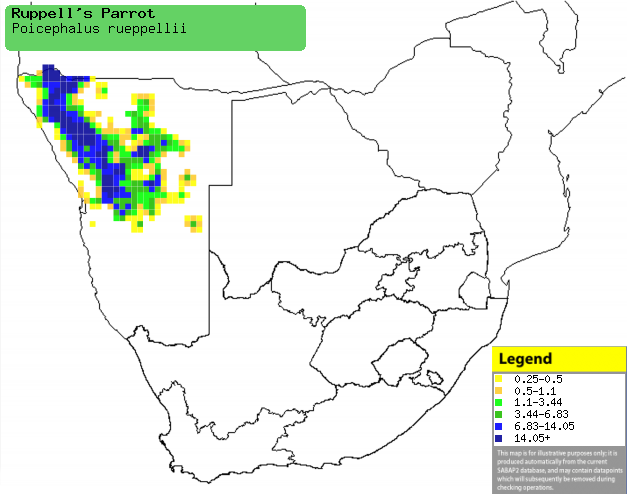|
Poicephalus rueppellii (Rüppell's
parrot)
Bloupenspapegaai [Afrikaans]; Rüppell-papegaai [Dutch];
Perroquet de Rüppell [French]; Rüppellpapagei [German]; Papagaio de Rüppell
[Portuguese]
Life
> Eukaryotes >
Opisthokonta
> Metazoa (animals) >
Bilateria >
Deuterostomia > Chordata >
Craniata > Vertebrata (vertebrates) > Gnathostomata (jawed
vertebrates) > Teleostomi (teleost fish) > Osteichthyes (bony fish) > Class:
Sarcopterygii (lobe-finned
fish) > Stegocephalia (terrestrial
vertebrates) > Tetrapoda
(four-legged vertebrates) > Reptiliomorpha > Amniota >
Reptilia (reptiles) >
Romeriida > Diapsida > Archosauromorpha > Archosauria >
Dinosauria
(dinosaurs) > Saurischia > Theropoda (bipedal predatory dinosaurs) >
Coelurosauria > Maniraptora > Aves
(birds) >
Order: Psittaciformes > Family: Psittacidae
The Rüppell's parrot is near endemic to Namibia, occurring in
habitats ranging from riparian woodland to Acacia as well as palm tree
stands. Its diet varies according to time of year, eating a range of plants and
occasionally insects. It nest's in tree cavities (especially cluster leafs and
Acacia), either natural or excavated by woodpeckers. Here it lays 3-5
eggs, which are incubated for about 24-30 days, mainly by the female (recorded
in captivity). In captivity, the chicks stay in the nest for about 50-51 days.
Its population numbers are threatened by the cage bird trade - an estimated
600-1000 birds are exported annually to South Africa and Europe, about 60-70% of
which die while in transit.
Distribution and habitat
Near endemic to central and northern Namibia, as its
distribution extends to southern Angola. In the northern part of its range it
prefers riparian woodland and stands of Northern lala palms (Hypheane petersiana). In
central Namibia it may also occur in
mixed Acacia woodland and cluster-leaf (Terminalia) stands.
|
 |
|
Distribution of Rüppell's parrot in southern Africa,
based on statistical smoothing of the records from first SA Bird Atlas
Project (©
Animal Demography unit, University of
Cape Town; smoothing by Birgit Erni and Francesca Little). Colours range
from dark blue (most common) through to yellow (least common). |
Call
Food
Its diet varies according to time of
year, eating a range of plants and occasionally insects. The following food
items have been recorded in its diet:
- Plants
- seeds, buds and shoots of Acacia
- flowers and fruit of Grewia (raisins)
- nectar of Tapinthus (mistletoes)
- fruit
- Ficus (figs)
- Combretum (bushwillows)
- Invertebrates
Breeding
- It nests in tree cavities, either natural or excavated
by woodpeckers. It especially favours cavities in cluster-leafs), Acacia erioloba (Camel thorn) and Olea europea
(African olive), as these trees are fairly common in some of its
favoured habitats.
- Egg-laying season is from January-June, peaking from January-March.
- It lays 3-5 eggs, which are incubated for about 24-30 days, mainly by
the female (recorded in captivity).
- In captivity the chicks stay in the nest for about 50-51 days.
Threats
Not threatened, however its population numbers are
threatened by the cage bird trade - an estimated 600-1000 birds are exported
annually to South Africa and Europe, approximately 60-70% of which die while in transit.
References
-
Hockey PAR, Dean WRJ and Ryan PG (eds) 2005. Roberts
- Birds of southern Africa, VIIth ed. The Trustees of the John Voelcker
Bird Book Fund, Cape Town.
|
